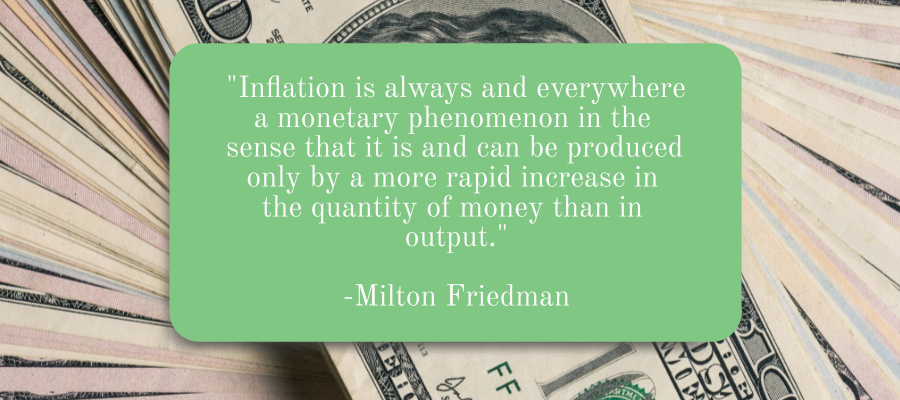Mainstream analysis sees rising consumer prices, and looks for a monetary cause. Also, when it sees an increase in the quantity of dollars, it looks for rising consumer prices.
It is a fact that the quantity of what the mainstream calls money (i.e. the dollar) has risen at an extraordinary rate. The M0 measure has nearly doubled since the start of Covid. It is also a fact that many prices have jumped up significantly.
So only one question is open for debate. Is inflation transitory as Fed apologists claim? Or is it now running away, as Fed critics worry?
The wrong question about inflation
We think this is the wrong question. Bear with us as we review some ideas we’ve discussed previously (though in a new light). We will add some new ideas, and then get back to the present question about prices.
We have written a lot of material about nonmonetary forces that drive up prices. We coined a term for the most common one: useless ingredients. This is when a regulator forces producers to literally or figuratively add stuff to their products, which consumers do not value (and often do not even know about).
For example, a baker bakes bread using the well-know ingredients of flour, water, and yeast. But a regulator forces him to add a preservative. Presto, the price of a loaf jumps 10%. The consumer price index also jumps 10% (assuming that regulators of the other goods in the basket measured by the index are also adding useless ingredients). People say “aah, inflation” and point to a chart of M0 or M3 or whatever, and nod sagely.
This is not a monetary phenomenon.

It was not caused by the Fed. The Fed should not do anything differently from what it was previously doing (ceding, for argument’s sake that the Fed should ever be doing anything, or even exist at all). Interest rates should not change. Investors should not demand higher returns (assuming they weren’t disenfranchised in our regime of irredeemable currency). One should not say that the dollar’s purchasing power is lessened. The dollar is buying just as much as it did before. Only now, some of what it buys is stuff that the consumer does not want, and may not even know is in the bread, i.e. calcium propionate.
We have written that when interest rates fall, it both enables and forces producers to borrow more to increase production. For example, the interest rate is 5%. The baker does not think it will be profitable to borrow to buy more ovens to bake more bread. Then the interest rate drops to 4%. Now it is profitable. So the baker borrows and expands. Unfortunately, so do his competitors. Unless the public increases its appetite for bread, the price must inevitably drop.
The same thing happens with oven manufacturers, and every other producer of goods. Lower interest rates is an incentive to borrow more to build more plant to produce more goods.
It goes against everything taught in mainstream economics, but this is how an increase in the quantity of dollars can cause prices to go down. When those dollars are borrowed by producers, on a downtick in rates. The result is soft prices, if not falling prices. And falling unit margins.
Even if the government doles out free cash to a hundred million people, and tells them to go forth and spend, there is not necessarily rising prices. Sure, demand rises. But so long as interest rates remain the same or continue to fall, producers borrow more to expand capacity to serve this new demand. And while the demand is temporary, depending on political will, the capacity once built is there for a long time.
This also seems counterintuitive. It seems to make sense to think of an increase in the quantity of dollars like dilution. The orphanage has a certain amount of food to put in the soup, but another hungry mouth comes to dinner. They add water. Everyone gets the same volume of soup as before, but the calorie value of it decreases.
Understanding the purchasing power of the dollar
It’s tempting to think of currency like this. And convenient. It’s a simple linear and static model. There is one independent variable—quantity—and one dependent variable—purchasing power. Tempting as it may be to view it this way, this has nothing to do with reality.
OK, one might say, if the extra purchasing power of the welfare beneficiaries who get the free cash does not come out of the purchasing power of everyone else’s dollar, then where does it come from?
It comes from the accumulated capital stock. It robs the savers of their savings. Recall, we just saw that producers, of the things which the free cash crowd purchase, borrowed to expand their bakeries and factories. This does not push up the price of bread and manufactured goods. To reiterate, it robs the savers of their savings. Their savings has gone, not to finance production of goods which are ultimately exchanged for other goods, but goods which just go into the black hole of consumers who produce nothing.
There is no problem with the purchasing power of your dollar. The problem is with the counterfeit credit into which your life savings is lent. And the result is that yield purchasing power for all capital assets keeps dropping.
A Different Era
The 1950’s through 1970’s was a period of rising consumer prices. And this was a monetary phenomenon. Back then, producers did not leisurely wait for a downtick in interest rates. They did not borrow to increase production capacity. They aggressively bid up the rate, to increase their inventory buffers of raw materials and partially-completed products.
There was not only a faster rate of buying commodities than consuming finished goods. But the former rate was growing relative to the latter. The most surefire way to increase profits, was to slow down the path from raw materials to finished goods. The longer it took, the greater the profit. This was because prices were incessantly rising.
And look at the incentive offered by the interest rate. Back then, it was rising. That meant that it was harder and harder to justify borrowing to build a plant (now, with a falling rate, it is easier and easier to justify borrowing to build a plant). Indeed, when old plant reached the end of its life, there may not have been a business case to replace it. It may have been economic to shut it down entirely.
Money and credit – it’s just not that simple
We write all of this to make a simple point about a not-so-simple system. To understand the monetary cause of rising or falling prices, one has to see the motion. It’s a dynamic system, with the rate of one process changing relative to the rate of another.
The classic chart of supply and demand is a static snapshot. It can’t tell you whether the rate of increase of supply is outstripping the rate of increase of demand, which may be static or declining. It can’t tell you which way interest rates are going, and what effect that trend will have on supply or demand.
This brings us to today. In our post-Covid (or soon-to-be post-Covid) economy, prices have risen. People call this inflation, point at the increase in the quantity of dollars, and blame the Fed. They debate if this inflation is transitory. By which they mean will the Fed keep printing more, and will that printing continue to cause rising prices.
As we discussed above, these are the wrong questions (aside from which, the Fed does not print—it borrows).
So, why are prices rising if not because of inflation?
The question is what caused prices to rise? Let’s call our thesis “lockdown whiplash”. Whiplash is when something is forcefully slammed in one direction, then rapidly accelerated in the opposite direction.
First, governments locked down the economy in response to the Covid virus. This did not just close restaurants. Notably, a significant percentage of the meat packing plants in the US were closed. The immediate result was that ranchers and farmers suffered great losses, as they had to destroy herds. At the same time, the price of meat at the grocery store skyrocketed.
Was this inflation? Cattle and hogs went “no bid”. So the price received by ranchers and farmers was zero. They certainly did not feel any inflation. With supply decimated, consumers paid a lot more. They considered this to be inflation, though it was clearly nonmonetary.
Fast forward a bit. Some plants may have gone out of business. Certainly, some farmers and ranchers did. It doesn’t help that they were already loaded up on debt, thanks to 39 years of falling interest rates luring them to borrow more—pre Covid.
With supply tight for the time being, prices must be higher than before. Is this inflation?
Next, let’s look at the shipping business. During the height of lockdown, shipping from China to America came to a standstill. The ships and the containers were stranded where they happened to be, as the flow stopped.
At the same time, demand also dried up. Retailers were obviously not ordering more merchandise. As people lost their jobs by the millions, they reduced their purchases of stuff. And certainly, nobody was going shopping in retail stores.
With retail now reopened, people are catching up on the things they had put off buying. Much of this buying was not cancelled, just postponed to today.
The problem for the shipping industry—and indeed the whole supply chain—is that it is designed for a steady rate of demand. It is not robust to a prolonged shutdown followed by a spike. Even though total goods bought, manufactured, and shipped may be the same, the industries involved were first laying off workers, going bankrupt never to return, shutting down marginal plant, etc.
Then, later, demand spikes. Most businesses would not be able to handle a year and half worth of volume compressed into a few months, even before Covid. And after, with reduced staff and plant, there is no way.
Add to this, that governments around the world instituted welfare programs to pay people who lost their jobs. In many cases, these former workers prefer to remain unemployed. They are paid as much or more to sit on the couch playing X-Box than to go to work.
Add to this the extra demand due to various kinds of stimulus checks. And then there is the so-called “wealth effect”. This is economists’ term for the increase in consumer spending that comes when the central bank pushes down the rate of interest, and hence pushes up asset prices. Such as home prices.
How many people are buying more stuff, because they feel richer, because their homes went up in value? We don’t know—but we do know that much of the stuff they are buying is competing with other goods to get into the limited container capacity available to bring stuff over from China.
What a mess!
The one thing we can be sure of is that falling interest rates are, even now, stimulating companies in every industry from cattle ranching to meat packing to container manufacturing to borrow more to build more capacity to produce more of these goods, at higher volumes and lower costs.
Of course, there is a lag time to bring new capacity online. But when it does, the 2021 headlines that scream “inflation will skyrocket in the coming years” will look rather silly. The way the ones from 2009 do.
© 2021 Monetary Metals

